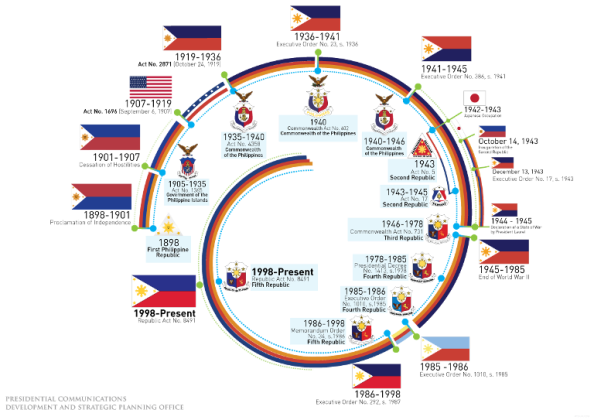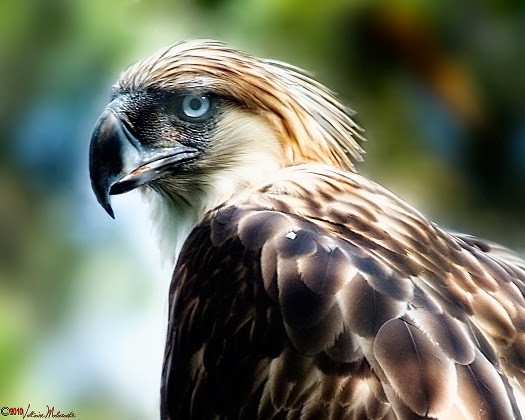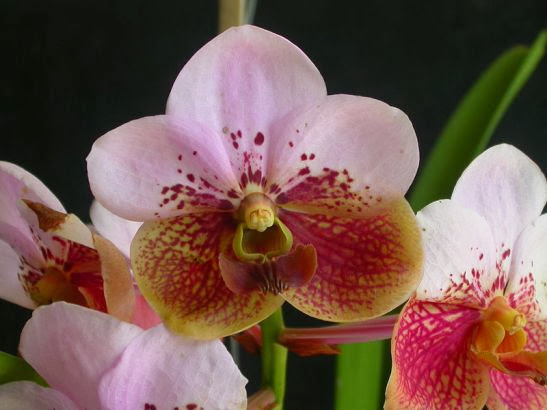I was among those who grew up believing that sipa, maya, mango and anahaw were national symbols. After all, those were what were in our textbooks. I learned as a grown up that not all of the symbols we were taught in school are recognized by the law. I would not be surprised if others who had gone to school with me are unaware that there are official symbols. A recent episode of GMA News TV’s Investigative Documentaries (ID) showed members of older generations fumbling for answers to questions about national symbols. Thankfully, the show has ventured to set the record straight and inform the public.
Official National Symbols
ID, in their January 30, 2014 episode listed ten. I’ve added the notes to these based on government website sources.
1. National Flag
The first version of our country’s national flag was first waved by Aguinaldo as he stood on the balcony of his residence in Cavite on June 12, 1898, following the proclamation of independence from Spain. In the following decades, the national flag underwent numerous changes, including at one point, the blue portion shifting to light blue.
In 1998, during the time of President Fidel V. Ramos, Republic Act No. 8491 or the Flag and Heraldic Code of the Philippines was enacted stipulating the regulations for its design and display as well as conduct towards it.

2. National Anthem – Lupang Hinirang
The law stipulates that the national anthem should always be sung in Filipino and following the musical arrangement and composition of Julian Felipe. According to the National Historical Institute, the correct tempo is 2/4 and is in keeping with its original form as a march and not 4/4 as some sing it.
3. National Coat-of-Arms
Republic Act No. 8491 dictates that the Coat-of-Arms shall have:
“Paleways of two (2) pieces, azure and gules; a chief argent studded with three (3) mullets equidistant from each other; and, in point of honor, ovoid argent over all the sun rayonnant with eight minor lesser rays. Beneath shall be the scroll with the words “REPUBLIKA NG PILIPINAS,” inscribed thereon.”
4. National Language – Filipino
With more than a hundred (close to two hundred) languages and dialects in the Philippines, some people still get a little testy over discussions about the national language. Some contend that Filipino is but a formal term for what is essentially Tagalog, in which case the implication is that all others have been excluded. Others maintain that Tagalog is but the nuclei of the national language.
In any case Article XIV of the 1987 Constitution states that:
“The national language of the Philippines is Filipino. As it evolves, it shall be further developed and enriched on the basis of existing Philippine and other languages.”
5. National Motto
Republic Act No. 8491 states that the national motto shall be: Maka-Diyos, Maka-Tao, Makakalikasan at Makabansa
6. National Sport – Arnis
Republic Act No. 9850 which was signed into law by President Gloria Macapagal Arroyo on December 11, 2009, made arnis the national martial art and sport of the Philippines.
7. National Tree – Narra
In 1934, the American Governor General Frank Murphy declared the narra as the national tree, through Proclamation No. 652
8. National Flower – Sampaguita
It was also Murphy who declared the sampaguita as the national flower in the same proclamation.
9. National Bird – Philippine Eagle
Once known as the monkey-eating eagle, it is now known as the Philippine eagle by virtue of Proclamation No. 1732 by President Ferdinand E. Marcos in 1978. It was declared the national bird by President Fidel V. Ramos in 1995 through Proclamation No. 615. It is currently critically endangered.

10. National Gem – South Sea Pearl
President Fidel V. Ramos contributed yet again to our list of national symbols by declaring the south sea pearl, also known as the Philippine pearl as the national gem in 1996 with Proclamation No. 905
A Question of Heroes
Among those not included in the list of national symbols is Jose Rizal, who, nonetheless is called by many Filipinos as the national hero. The title goes back to the time of the Americans where it is said our colonizers preferred Rizal for national hero. Apparently, there is no official Philippine law that has officially conferred the title to him.
In an interview by ID, NHCP historian Ian Christopher Alfonso clarified that there can’t be a national hero simply because all our heroes did what they could for the Philippines. The implication is that, it would be unfair to pick one to elevate to the position of national hero over all the others.
Cultural Sensitivity
Other commonly known symbols are not recognized by law because they are more representative of regional cultures rather than the Philippines as a whole. In ID, Cultural Anthropologist Nestor Castro explained that not all Filipinos are Tagalogs and therefore do not all wear Barong Tagalog and Baro’t Saya. Kerby Alvarez of the UP Diliman Department of History also added that it would be culturally insensitive to pick Lechon as a national symbol because not all Filipinos eat this.
Cultural diversity can also be deemed as the reason why the government cannot recognize the Bahay Kubo, Adobo, Sinigang, Bahay Kubo and Bakya as national symbols.
Political Motivations
Older generations would remember being taught in school that Tinikling was the national dance. Interestingly, Castro in ID, recounted how in 1992, DepEd replaced Tinikling with Carinosa as the national dance. This may have been a self-serving declaration, since the Education secretary then was named Carino. In any case, neither Tinikling nor Carinosa have been officially recognized by law as national symbols.
Castro also pointed out the case of the Waling-Waling. There is a move by legislators to make it a national flower. The orchid is endemic to the Philippines which is perhaps one reason why it would make a good national symbol. Castro is of the opinion however, that legislators have only really taken into consideration the views of people from the orchid industry, and there he thinks is the problem. Castro thinks politicians keep making laws about national symbols without consulting the general public.

Uniquely Filipino
Those who went to school in the 1980s would remember sipa as the national sport. The justification for its having been replaced by arnis is that sipa is a sport that is not distinctly Filipino and is commonly played in other Southeast Asian countries. Hence, the predominant idea here is that national symbols are chosen too for how distinctly Filipino they are.
It is worth noting however that there are existing national symbols that are not purely Filipino in origin. The sampaguita and narra for example are found in numerous other countries. The sampaguita in particular is said to have originated from India and is also considered a national symbol in Indonesia.
The question now really, is whether our symbols should be chosen based on cultural uniqueness or on public recognition and perception.
Common Experience
There are a handful of other symbols that many Filipinos would think are national symbols, not just because they were taught in school but because, once upon a time, they were widely and commonly seen and experienced. These include the maya that has been supplanted by the Philippine Eagle. Others that have not been officially recognized by law are the anahaw leaf, mango fruit, bangus and carabao.
Undoubtedly, there will be those who will argue that there are far greater national concerns than debates and laws about national symbols. It is worth keeping in mind however, that our symbols and their evolution are part of our identity and development as a people and a nation. It’s important to know what makes us who we are.
Here’s my formal proposition which I hope the lawmakers of the love will give full consideration.
National Hero – Don Facundo
National House – Bungalow
National Flower – Santan
National Sport – Gulp
That is why That is why phillipino low self eeetsm! Why Indian didnot claim they are white kind or mix Britain even they were under british colony. So as african! Indian are respectful race and deserve it and they are proud of their own culture. Plus east Asia are shameful of being colonized and dont even want to mention the history part. I don’t understand why you guys try to link Spanish to you, did Spain claim anything or you re their own?! Not really .. Be proud of your own race and stop marrying older
bakit naman po naging waling-waling ang panbansang bulaklak?
opo
so what are the 6 main national official symbols?